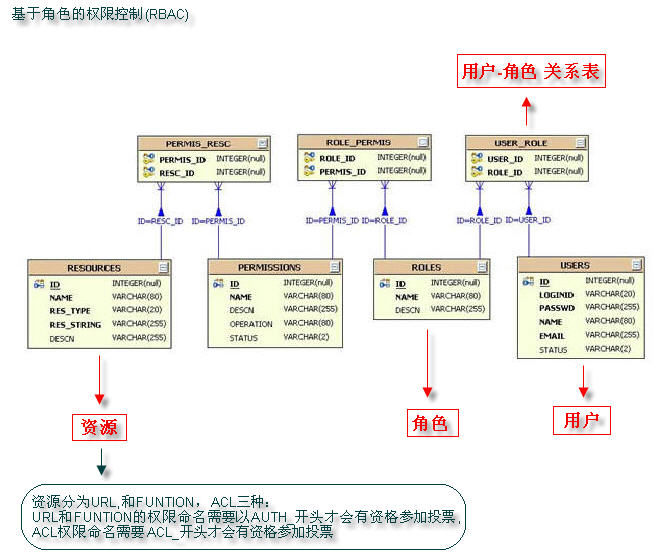Acegi安全系统介绍
??? Acegi是Spring Framework 下最成熟的安全系统,它提供了强大灵活的企业级安全服务,如:
??? 1 : 完善的认证和授权机制,
??? 2 : Http资源访问控制,
??? 3 : Method 调用访问控制,
??? 4 : Access Control List (ACL) 基于对象实例的访问控制,
??? 5 : Yale Central Authentication Service (CAS) 耶鲁单点登陆,
??? 6 : X509 认证,
??? 7 : 当前所有流行容器的认证适配器,
??? 8 : Channel Security频道安全管理等功能。
具体 :
Http资源访问控制
http://apps:8080/index.htm -> for public
http://apps:8080/user.htm -> for authorized user
方法调用访问控制
public void getData() -> all user
public void modifyData() -> supervisor only
对象实例保护
order.getValue() < $100 -> all user
order.getValue() > $100 -> supervisor only
Acegi是非入侵式安全架构 因为 :
基于Servlet Filter和Spring aop,? 使商业逻辑和安全逻辑分开,结构更清晰
使用Spring 来代理对象,能方便地保护方法调用
基于角色的权限控制(RBAC)? :
Acegi 自带的 sample 表设计很简单: users表{username,password,enabled} authorities表{username,authority},这样简单的设计无法适应复杂的权限需求,故SpringSide选用RBAC模型对权限控制数据库表进行扩展。 RBAC(Role-Based Access Control)引入了ROLE的概念,使User(用户)和Permission(权限)分离,一个用户拥有多个角色,一个角色拥有有多个相应的权限,从而减少了权限管理的复杂度,可更灵活地支持安全策略。
?
同时,我们也引入了resource(资源)的概念,一个资源对应多个权限,资源分为ACL,URL,和FUNTION三种。注意,URL和FUNTION的权限命名需要以AUTH_开头才会有资格参加投票, 同样的ACL权限命名需要ACL_开头。
2.1? 在Web.xml中的配置 :
1)? FilterToBeanProxy
Acegi通过实现了Filter接口的FilterToBeanProxy提供一种特殊的使用Servlet Filter的方式,它委托Spring中的Bean -- FilterChainProxy来完成过滤功能,这好处是简化了web.xml的配置,并且充分利用了Spring IOC的优势。FilterChainProxy包含了处理认证过程的filter列表,每个filter都有各自的功能。
1<filter>
2??? <filter-name>securityFilter</filter-name>
3??? <filter-class>org.acegisecurity.util.FilterToBeanProxy</filter-class>
4??? <init-param>
5??????? <param-name>targetClass</param-name>
6??????? <param-value>org.acegisecurity.util.FilterChainProxy</param-value>
7??? </init-param>
8</filter>
2) filter-mapping
<filter-mapping>限定了FilterToBeanProxy的URL匹配模式,
1<filter-mapping>
2??? <filter-name>securityFilter</filter-name>
3??? <url-pattern>/j_security_check</url-pattern>
4</filter-mapping>
5
6<filter-mapping>
7??? <filter-name>securityFilter</filter-name>
8??? <url-pattern>/dwr/*</url-pattern>
9</filter-mapping>
10
11<filter-mapping>
12??? <filter-name>securityFilter</filter-name>
13??? <url-pattern>*.html</url-pattern>
14</filter-mapping>
15
16<filter-mapping>
17??? <filter-name>securityFilter</filter-name>
18??? <url-pattern>*.jsp</url-pattern>
19</filter-mapping>?
3) HttpSessionEventPublisher
<listener>的HttpSessionEventPublisher用于发布HttpSessionApplicationEvents和HttpSessionDestroyedEvent事件给spring的applicationcontext。
1??? <listener>
2??????? <listener-class>org.acegisecurity.ui.session.HttpSessionEventPublisher</listener-class>
3??? </listener>
4
注:appfuse1.9.3中没有发现这个 监听器
--------------------------------------
2.2 : 在applicationContext-acegi-security.xml中
2.2.1 FILTER CHAIN
FilterChainProxy会按顺序来调用这些filter,使这些filter能享用Spring ioc的功能, CONVERT_URL_TO_LOWERCASE_BEFORE_COMPARISON定义了url比较前先转为小写, PATTERN_TYPE_APACHE_ANT定义了使用Apache ant的匹配模式
1??? <bean id="filterChainProxy" ref="jdbcDaoImpl"/>???????
3??? <property name="userCache" ref="userCache"/>???????
4??? <property name="passwordEncoder" ref="passwordEncoder"/>??
5</bean>
3) passwordEncoder
使用加密器对用户输入的明文进行加密。Acegi提供了三种加密器:
1a :? PlaintextPasswordEncoder—默认,不加密,返回明文.
2b : ShaPasswordEncoder—哈希算法(SHA)加密
3c : Md5PasswordEncoder—消息摘要(MD5)加密
1<bean id="passwordEncoder" ref="dataSource"/>
3??? <property name="usersByUsernameQuery">???
4??????? <value>select loginid,passwd,1 from users where loginid = ?</value>
5??? </property>??????
6??? <property name="authoritiesByUsernameQuery">???
7??????? <value>?
8???????????? select u.loginid,p.name from users u,roles r,permissions p,?
9???????????? user_role ur,role_permis rp where u.id=ur.user_id and??
10???????????? r.id=ur.role_id and p.id=rp.permis_id and r.id=rp.role_id and???
11???????????? p.status='1' and u.loginid=????
12??????? </value>
13??? </property>
14</bean>
5) userCache &? resourceCache
缓存用户和资源相对应的权限信息。每当请求一个受保护资源时,daoAuthenticationProvider就会被调用以获取用户授权信息。如果每次都从数据库获取的话,那代价很高,对于不常改变的用户和资源信息来说,最好是把相关授权信息缓存起来。(详见 2.6.3 资源权限定义扩展 )
userCache提供了两种实现: NullUserCache和EhCacheBasedUserCache, NullUserCache实际上就是不进行任何缓存,EhCacheBasedUserCache是使用Ehcache来实现缓功能。
1<bean id="userCacheBackend" ref="cacheManager"/>
3??? <property name="cacheName" value="userCache"/>
4</bean>
5
6<bean id="userCache"
????????? autowire="byName">
7??? <property name="cache" ref="userCacheBackend"/>?
8</bean>
9
10<bean id="resourceCacheBackend" ref="cacheManager"/>
12??? <property name="cacheName" value="resourceCache"/>
13</bean>
14
15<bean id="resourceCache"
???????? autowire="byName">
16??? <property name="cache" ref="resourceCacheBackend"/>
17</bean>
6) basicProcessingFilter
用于处理HTTP头的认证信息,如从Spring远程协议(如Hessian和Burlap)或普通的浏览器如IE,Navigator的HTTP头中获取用户
信息,将他们转交给通过authenticationManager属性装配的认证管理器。如果认证成功,会将一个Authentication对象放到会话中
,否则,如果认证失败,会将控制转交给认证入口点(通过authenticationEntryPoint属性装配)
1<bean id="basicProcessingFilter" ref="authenticationManager"/>
3??? <property name="authenticationEntryPoint" ref="basicProcessingFilterEntryPoint"/>
4</bean>
7) basicProcessingFilterEntryPoint
通过向浏览器发送一个HTTP401(未授权)消息,提示用户登录。
处理基于HTTP的授权过程, 在当验证过程出现异常后的"去向",通常实现转向、在response里加入error信息等功能。
1 <bean id="basicProcessingFilterEntryPoint"
2??????????? value="SpringSide Realm"/>
4</bean>
8) authenticationProcessingFilterEntryPoint
???? 当抛出AccessDeniedException时,将用户重定向到登录界面。属性loginFormUrl配置了一个登录表单的URL,当需要用户登录时,authenticationProcessingFilterEntryPoint会将用户重定向到该URL
1<bean id="authenticationProcessingFilterEntryPoint"
2????? value="false"/>
7</bean>
2.2.3 HTTP安全请求
1) httpSessionContextIntegrationFilter
每次request前 HttpSessionContextIntegrationFilter从Session中获取Authentication对象,在request完后, 又把Authentication对象保存到Session中供下次request使用,此filter必须其他Acegi filter前使用,使之能跨越多个请求。
1<bean id="httpSessionContextIntegrationFilter"
2??????????????? value="false"/>
3??? <property name="decisionVoters">?
4??????? <list>
5??????????? <ref bean="roleVoter"/>?
6??????? </list>
7??? </property>
8</bean>
3) roleVoter
必须是以rolePrefix设定的value开头的权限才能进行投票,如AUTH_ , ROLE_
1<bean id="roleVoter" value="AUTH_"/>??
3</bean>
4)exceptionTranslationFilter
异常转换过滤器,主要是处理AccessDeniedException和AuthenticationException,将给每个异常找到合适的"去向"
1<bean id="exceptionTranslationFilter" ref="authenticationProcessingFilterEntryPoint"/>
3</bean>
5) authenticationProcessingFilter
和servlet spec差不多,处理登陆请求.当身份验证成功时,AuthenticationProcessingFilter会在会话中放置一个Authentication对象,并且重定向到登录成功页面
???????? authenticationFailureUrl定义登陆失败时转向的页面
???????? defaultTargetUrl定义登陆成功时转向的页面
???????? filterProcessesUrl定义登陆请求的页面
???????? rememberMeServices用于在验证成功后添加cookie信息
1<bean id="authenticationProcessingFilter"
?????????????? ref="authenticationManager"/>
3??? <property name="authenticationFailureUrl">
4??????? <value>/security/login.jsp?login_error=1</value>
5??? </property>
6??? <property name="defaultTargetUrl">
7??????? <value>/admin/index.jsp</value>
8??? </property>
9??? <property name="filterProcessesUrl">
10??????? <value>/j_acegi_security_check</value>
11??? </property>
12??? <property name="rememberMeServices" ref="rememberMeServices"/>
13</bean>
6) filterInvocationInterceptor
在执行转向url前检查objectDefinitionSource中设定的用户权限信息。首先,objectDefinitionSource中定义了访问URL需要的属性信息(这里的属性信息仅仅是标志,告诉accessDecisionManager要用哪些voter来投票)。然后,authenticationManager掉用自己的provider来对用户的认证信息进行校验。最后,有投票者根据用户持有认证和访问url需要的属性,调用自己的voter来投票,决定是否允许访问。
1<bean id="filterInvocationInterceptor" ref="authenticationManager"/>
3??? <property name="accessDecisionManager" ref="httpRequestAccessDecisionManager"/>
4??? <property name="objectDefinitionSource" ref="filterDefinitionSource"/>
5</bean>
7)filterDefinitionSource(详见 2.6.3 资源权限定义扩展)
自定义DBFilterInvocationDefinitionSource从数据库和cache中读取保护资源及其需要的访问权限信息
1<bean id="filterDefinitionSource"
2? value="true"/>???????
4??? <property name="useAntPath" value="true"/>???????
5??? <property name="acegiCacheManager" ref="acegiCacheManager"/>
6</bean>
2.2.4 方法调用安全控制
(详见 2.6.3 资源权限定义扩展)
1) methodSecurityInterceptor
在执行方法前进行拦截,检查用户权限信息
1<bean id="methodSecurityInterceptor"
2??????? ref="authenticationManager"/>???????
4??? <property name="accessDecisionManager" ref="httpRequestAccessDecisionManager"/>???????
5??? <property name="objectDefinitionSource" ref="methodDefinitionSource"/>
6</bean>
2) methodDefinitionSource
自定义MethodDefinitionSource从cache中读取权限
1<bean id="methodDefinitionSource"
2????? ref="acegiCacheManager"/>???
4</bean>
?